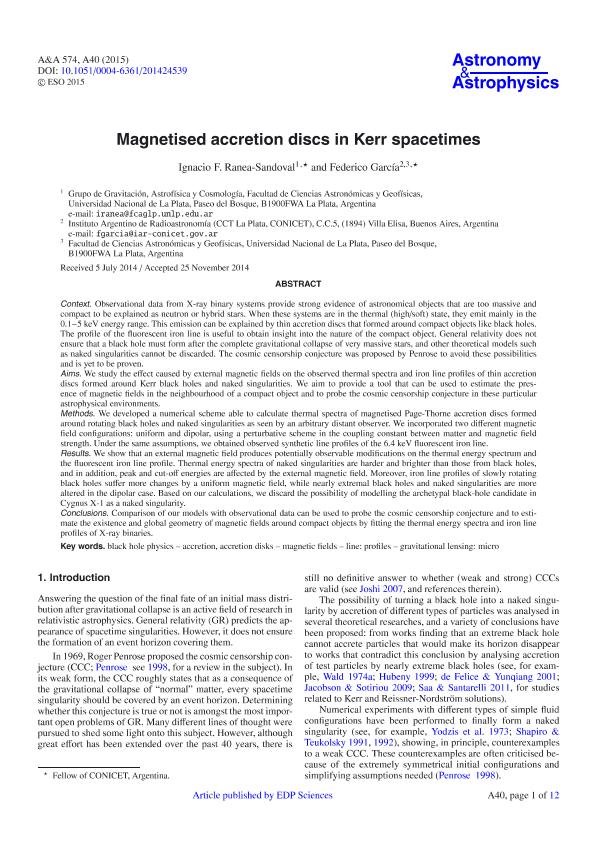Mostrar el registro sencillo del ítem
dc.contributor.author
Ranea Sandoval, Ignacio Francisco

dc.contributor.author
García, Federico

dc.date.available
2016-09-07T19:28:34Z
dc.date.issued
2015-02
dc.identifier.citation
Ranea Sandoval, Ignacio Francisco; García, Federico; Magnetised accretion discs in Kerr spacetimes; EDP Sciences; Astronomy and Astrophysics; 574; 40; 2-2015; 1-12
dc.identifier.issn
0004-6361
dc.identifier.uri
http://hdl.handle.net/11336/7535
dc.description.abstract
Context. Observational data from X-ray binary systems provide strong evidence of astronomical objects that are too massive and compact to be explained as neutron or hybrid stars. When these systems are in the thermal (high/soft) state, they emit mainly in the 0.1−5 keV energy range. This emission can be explained by thin accretion discs that formed around compact objects like black holes. The profile of the fluorescent iron line is useful to obtain insight into the nature of the compact object. General relativity does not ensure that a black hole must form after the complete gravitational collapse of very massive stars, and other theoretical models such as naked singularities cannot be discarded. The cosmic censorship conjecture was proposed by Penrose to avoid these possibilities and is yet to be proven.
Aims. We study the effect caused by external magnetic fields on the observed thermal spectra and iron line profiles of thin accretion discs formed around Kerr black holes and naked singularities. We aim to provide a tool that can be used to estimate the presence of magnetic fields in the neighbourhood of a compact object and to probe the cosmic censorship conjecture in these particular astrophysical environments.
Methods. We developed a numerical scheme able to calculate thermal spectra of magnetised Page-Thorne accretion discs formed around rotating black holes and naked singularities as seen by an arbitrary distant observer. We incorporated two different magnetic field configurations: uniform and dipolar, using a perturbative scheme in the coupling constant between matter and magnetic field strength. Under the same assumptions, we obtained observed synthetic line profiles of the 6.4 keV fluorescent iron line.
Results. We show that an external magnetic field produces potentially observable modifications on the thermal energy spectrum and the fluorescent iron line profile. Thermal energy spectra of naked singularities are harder and brighter than those from black holes, and in addition, peak and cut-off energies are affected by the external magnetic field. Moreover, iron line profiles of slowly rotating black holes suffer more changes by a uniform magnetic field, while nearly extremal black holes and naked singularities are more altered in the dipolar case. Based on our calculations, we discard the possibility of modelling the archetypal black-hole candidate in Cygnus X-1 as a naked singularity.
Conclusions. Comparison of our models with observational data can be used to probe the cosmic censorship conjecture and to estimate the existence and global geometry of magnetic fields around compact objects by fitting the thermal energy spectra and iron line profiles of X-ray binaries.
dc.format
application/pdf
dc.language.iso
eng
dc.publisher
EDP Sciences

dc.rights
info:eu-repo/semantics/openAccess
dc.rights.uri
https://creativecommons.org/licenses/by/2.5/ar/
dc.subject
Black Hole Physics
dc.subject
Accretion, Accretion Disks
dc.subject
Magnetic Fields
dc.subject
Line: Profiles
dc.subject.classification
Astronomía

dc.subject.classification
Ciencias Físicas

dc.subject.classification
CIENCIAS NATURALES Y EXACTAS

dc.title
Magnetised accretion discs in Kerr spacetimes
dc.type
info:eu-repo/semantics/article
dc.type
info:ar-repo/semantics/artículo
dc.type
info:eu-repo/semantics/publishedVersion
dc.date.updated
2016-07-26T15:12:49Z
dc.journal.volume
574
dc.journal.number
40
dc.journal.pagination
1-12
dc.journal.pais
Francia

dc.journal.ciudad
Paris
dc.description.fil
Fil: Ranea Sandoval, Ignacio Francisco. Universidad Nacional de la Plata. Facultad de Cs.astronomicas y Geofisicas. Area Fisica Teorica; Argentina
dc.description.fil
Fil: García, Federico. Consejo Nacional de Investigaciones Científicas y Técnicas. Centro Científico Tecnológico la Plata. Instituto Argentino de Radioastronomia (i); Argentina. Universidad Nacional de la Plata. Facultad de Ciencias Astronómicas y Geofísicas; Argentina
dc.journal.title
Astronomy and Astrophysics

dc.relation.alternativeid
info:eu-repo/semantics/altIdentifier/url/http://www.aanda.org/articles/aa/abs/2015/02/aa24539-14/aa24539-14.html
dc.relation.alternativeid
info:eu-repo/semantics/altIdentifier/doi/http://dx.doi.org/10.1051/0004-6361/201424539
Archivos asociados
